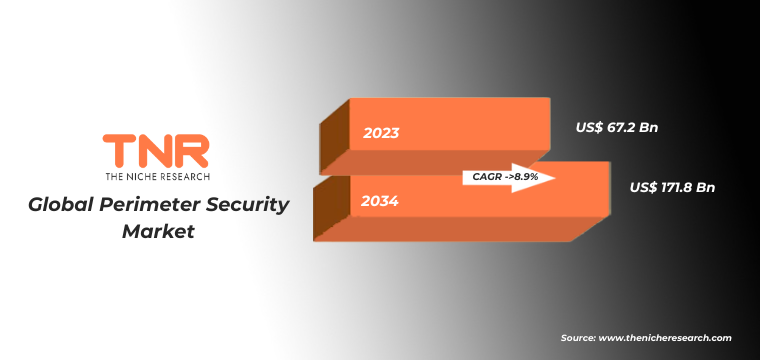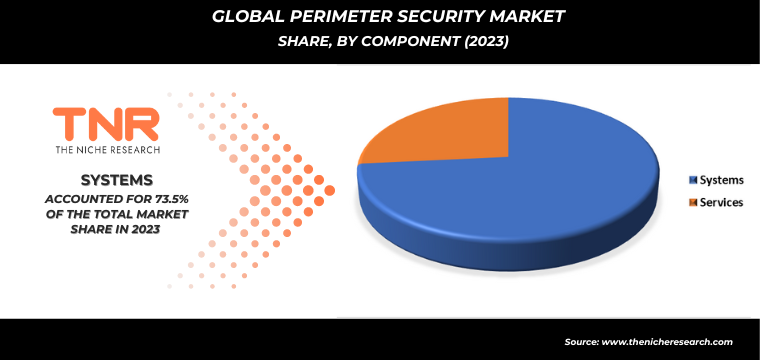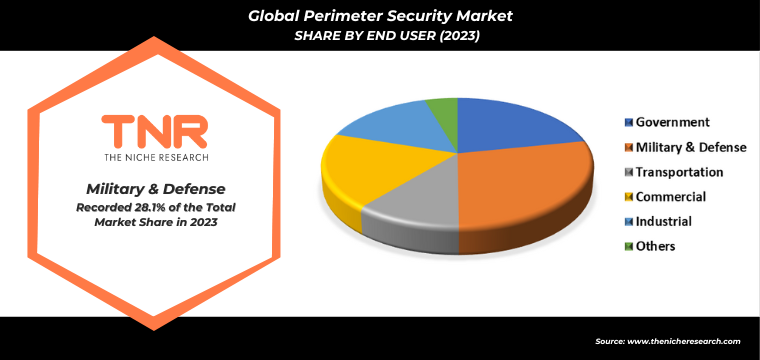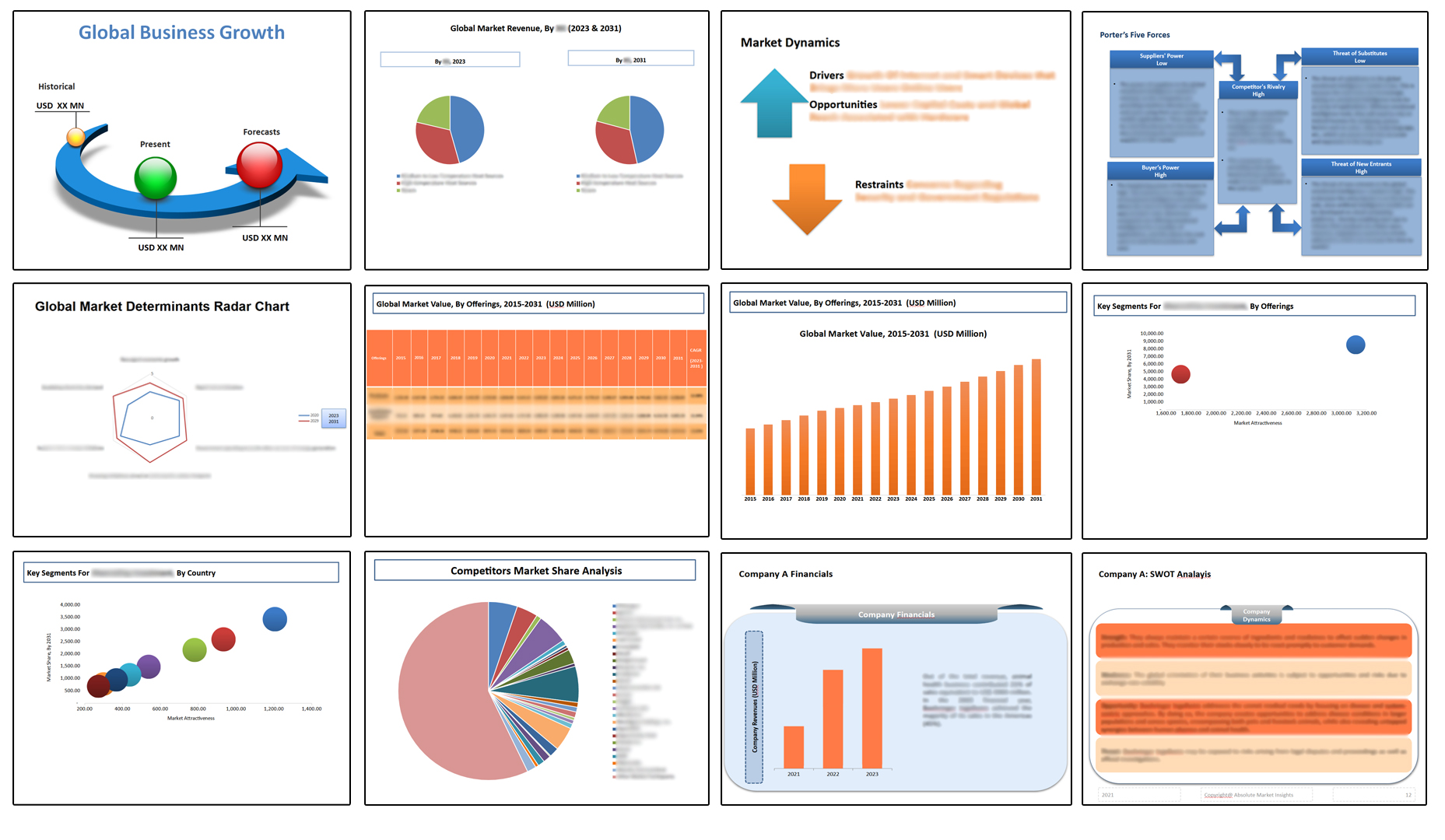Global Perimeter Security Market By Component, By End User, By Region & Segmental Insights Trends and Forecast, 2024 – 2034
- Industry: Technology
- Report ID: TNR-110-1270
- Number of Pages: 420
- Table/Charts : Yes
- August, 2024
- Base Year : 2024
- No. of Companies : 10+
- No. of Countries : 29
- Views : 10063
- Covid Impact Covered: Yes
- War Impact Covered: Yes
- Formats : PDF, Excel, PPT
The global perimeter security market encompasses technologies and solutions designed to protect the boundaries of a property or facility from unauthorized access and potential threats. Perimeter security includes systems like surveillance cameras, intrusion detection sensors, access control, and barriers, ensuring safety and security across various sectors. In commercial settings, it safeguards office buildings, retail centers, and banks, preventing theft and vandalism.
In terms of revenue, the global perimeter security market was worth US$ 67.2 Bn in 2023, anticipated to witness a CAGR of 8.9% during 2024 – 2034. Industrial applications involve securing manufacturing plants, warehouses, and critical infrastructure such as oil and gas facilities. Residential areas use perimeter security to protect private properties and gated communities. In government and defence, it secures military bases, prisons, and borders. Additionally, transportation hubs like airports, seaports, and railways rely on these systems to enhance safety and control access.

Growth Drivers in the Global Perimeter Security Market
- Rising Security Concerns: Increasing incidents of terrorism, theft, and vandalism are driving demand for advanced perimeter security solutions. Organizations across various sectors are investing in technologies like surveillance systems and access control to protect assets and ensure safety.
- Technological Advancements: Innovations in surveillance, AI, and sensor technologies are enhancing perimeter security capabilities. Smart cameras, facial recognition, and integrated systems provide real-time monitoring and threat detection, making security solutions more effective and appealing to diverse industries.
- Regulatory Compliance: Stringent government regulations and standards for security in critical infrastructure and public spaces are pushing organizations to adopt advanced perimeter security measures. Compliance with these regulations is essential for avoiding penalties and ensuring operational safety.
- Urbanization and Infrastructure Development: Rapid urbanization and the expansion of infrastructure projects globally are increasing the need for perimeter security. As new commercial, industrial, and residential areas emerge, the demand for comprehensive security solutions to safeguard these developments continues to grow.
Global Perimeter Security Market Revenue & Forecast, (US$ Million), 2016 – 2034
Systems have gained popularity in recent years and are anticipated to be the fastest-growing segment in the global perimeter security market during the forecast period. These systems, including advanced video surveillance, intrusion detection, and access control, offer comprehensive protection against potential threats. The increasing adoption of smart technologies, such as AI-driven analytics and IoT integration, has enhanced the effectiveness and reliability of these security systems. Industries across sectors, from commercial to critical infrastructure, are increasingly implementing these solutions to ensure safety and compliance with regulatory standards. The ongoing advancements in system capabilities, coupled with rising security concerns, are expected to drive substantial growth in this segment during the forecast period.

Military & defense segment accounted for the largest revenue share in 2023 in the global perimeter security market. Perimeter security systems are crucial in military and defense applications, where they protect sensitive facilities, military bases, and borders from unauthorized access, espionage, and potential threats. These systems include advanced surveillance technologies, intrusion detection sensors, and access control measures, all designed to ensure maximum security. With the integration of AI and real-time monitoring, military organizations can swiftly detect and respond to potential breaches, enhancing operational safety. The continuous investment in upgrading security infrastructure in defense establishments drives this segment’s significant market share.

The Middle East and Africa are expected to emerge as a dominating region in the global perimeter security market in the coming years. This growth is driven by increasing investments in critical infrastructure, such as oil and gas facilities, airports, and government buildings, where heightened security is paramount. The region faces significant security challenges, including geopolitical tensions and terrorism threats, prompting governments and private sectors to adopt advanced perimeter security solutions. Additionally, large-scale urbanization and infrastructure projects are further boosting demand for these systems. The focus on safeguarding strategic assets and ensuring public safety is positioning the Middle East and Africa as key players in the global market.

Global Perimeter Security Market Country Level Analysis:
United States: The United States leads the global perimeter security market, driven by innovations in AI-powered surveillance and integrated security solutions. Trends include increasing adoption of smart sensors, biometric access control, and advanced video analytics, particularly in critical infrastructure and defense sectors. The focus on cybersecurity integration further strengthens its market position.
China: China is a major player in the perimeter security market, with significant advancements in facial recognition and AI-driven surveillance technologies. Trends include large-scale implementation of smart city projects, with emphasis on public safety and border security. China’s rapid urbanization and infrastructure expansion fuel demand for cutting-edge perimeter security solutions.
United Kingdom: The United Kingdom excels in developing advanced perimeter security solutions, particularly in video surveillance and access control technologies. Key trends include the adoption of AI-enhanced analytics, facial recognition, and the integration of perimeter security systems with cybersecurity protocols. The focus on protecting critical national infrastructure and urban areas drives innovation in this market.
Competitive Landscape
The global perimeter security market is highly competitive, with key players focusing on innovation, mergers, and acquisitions to strengthen their market position. Major companies include Honeywell, Barrier1 Systems, and Axis Communications, all striving to offer advanced, integrated solutions for diverse industry needs.
Recent Developments:
- In August 2022, Honeywell introduced the Morley Max, a new fire detection and alarm system. This performance-based fire alarm center is designed with user-friendly features, making it lightweight, durable, and easy to operate. It ensures the safety of buildings and their occupants with innovative technologies like multi-boolean logic and inter-panel CANBus protocol, which enhance communication efficiency. Additionally, Honeywell Connected Life Safety Services (CLSS) simplifies panel connectivity.
- In June 2022, Dahua Technology launched the Night Color 2.0 Fusion Camera. Ideal for low-light environments requiring full-color imaging and discreet protection, this camera features advanced real-time perimeter protection, intelligent motion detection, ePoE, three-wire encryption, IP67 certification, and a wide dynamic range.
Some of the players operating in the perimeter security market are
- Axis Communications AB
- Barrier1 Systems, Inc.
- Cias Elettronica Srl
- Delta Scientific Corporation
- Honeywell International, Inc.
- Optex, Inc.
- Puretech Systems
- RBtec Perimeter Security Systems
- Senstar Corporation
- Tyco International Ltd.
- Other Industry Participants
Global Perimeter Security Market Scope:
| Report Specifications | Details |
| Market Revenue in 2023 | US$ 67.2 Bn |
| Market Size Forecast by 2034 | US$ 171.8 Bn |
| Growth Rate (CAGR) | 8.9% |
| Historic Data | 2016 – 2022 |
| Base Year for Estimation | 2023 |
| Forecast Period | 2024 – 2034 |
| Report Inclusions | Market Size & Estimates, Market Dynamics, Competitive Scenario, Trends, Growth Factors, Market Determinants, Key Investment Segmentation, Product/Service/Solutions Benchmarking |
| Segments Covered | By Component, By End User, By Region |
| Regions Covered | North America, Europe, Asia Pacific, Middle East & Africa, Latin America |
| Countries Covered | U.S., Canada, Mexico, Rest of North America, France, The UK, Spain, Germany, Italy, Nordic Countries (Denmark, Finland, Iceland, Sweden, Norway), Benelux Union (Belgium, The Netherlands, Luxembourg), Rest of Europe, China, Japan, India, New Zealand, Australia, South Korea, Southeast Asia (Indonesia, Thailand, Malaysia, Singapore, Rest of Southeast Asia), Rest of Asia Pacific, Saudi Arabia, UAE, Egypt, Kuwait, South Africa, Rest of Middle East & Africa, Brazil, Argentina, Rest of Latin America |
| Key Players | Axis Communications AB, Barrier1 Systems, Inc., Cias Elettronica Srl , Delta Scientific Corporation, Honeywell International, Inc., Optex, Inc., Puretech Systems, RBtec Perimeter Security Systems, Senstar Corporation, Tyco International Ltd. |
| Customization Scope | Customization allows for the inclusion/modification of content pertaining to geographical regions, countries, and specific market segments. |
| Pricing & Procurement Options | Explore purchase options tailored to your specific research requirements |
| Contact Details | Consult With Our Expert
Japan (Toll-Free): +81 663-386-8111 South Korea (Toll-Free): +82-808- 703-126 Saudi Arabia (Toll-Free): +966 800-850-1643 United Kingdom: +44 753-710-5080 United States: +1 302-232-5106 E-mail: askanexpert@thenicheresearch.com
|
Global Perimeter Security Market
By Component
- Systems
- Intrusion Detection Systems
- Video Surveillance Systems
- Access Control Systems
- Alarms & Notification Systems
- Perimeter Fencing
- Radar Systems
- Others
- Services
- System Integration & Consulting
- Risk Assessment and Analysis
- Maintenance and Support
- Managed Services
- Others
By End User
- Government
- Military & Defense
- Transportation
- Commercial
- Industrial
- Others
By Region
- North America (U.S., Canada, Mexico, Rest of North America)
- Europe (France, The UK, Spain, Germany, Italy, Nordic Countries (Denmark, Finland, Iceland, Sweden, Norway), Benelux Union (Belgium, The Netherlands, Luxembourg), Rest of Europe)
- Asia Pacific (China, Japan, India, New Zealand, Australia, South Korea, Southeast Asia (Indonesia, Thailand, Malaysia, Singapore, Rest of Southeast Asia), Rest of Asia Pacific)
- Middle East & Africa (Saudi Arabia, UAE, Egypt, Kuwait, South Africa, Rest of Middle East & Africa)
- Latin America (Brazil, Argentina, Rest of Latin America)
Report Layout:

Table of Contents
Note: This ToC is tentative and can be changed according to the research study conducted during the course of report completion.
**Exclusive for Multi-User and Enterprise User.
Global Perimeter Security Market
By Component
- Systems
- Intrusion Detection Systems
- Video Surveillance Systems
- Access Control Systems
- Alarms & Notification Systems
- Perimeter Fencing
- Radar Systems
- Others
- Services
- System Integration & Consulting
- Risk Assessment and Analysis
- Maintenance and Support
- Managed Services
- Others
By End User
- Government
- Military & Defense
- Transportation
- Commercial
- Industrial
- Others
By Region
- North America (U.S., Canada, Mexico, Rest of North America)
- Europe (France, The UK, Spain, Germany, Italy, Nordic Countries (Denmark, Finland, Iceland, Sweden, Norway), Benelux Union (Belgium, The Netherlands, Luxembourg), Rest of Europe)
- Asia Pacific (China, Japan, India, New Zealand, Australia, South Korea, Southeast Asia (Indonesia, Thailand, Malaysia, Singapore, Rest of Southeast Asia), Rest of Asia Pacific)
- Middle East & Africa (Saudi Arabia, UAE, Egypt, Kuwait, South Africa, Rest of Middle East & Africa)
- Latin America (Brazil, Argentina, Rest of Latin America)
The Niche Research approach encompasses both primary and secondary research methods to provide comprehensive insights. While primary research is the cornerstone of our studies, we also incorporate secondary research sources such as company annual reports, premium industry databases, press releases, industry journals, and white papers.
Within our primary research, we actively engage with various industry stakeholders, conducting paid interviews and surveys. Our meticulous analysis extends to every market participant in major countries, allowing us to thoroughly examine their portfolios, calculate market shares, and segment revenues.
Our data collection primarily focuses on individual countries within our research scope, enabling us to estimate regional market sizes. Typically, we employ a bottom-up approach, meticulously tracking trends in different countries. We analyze growth drivers, constraints, technological innovations, and opportunities for each country, ultimately arriving at regional figures.Our process begins by examining the growth prospects of each country. Building upon these insights, we project growth and trends for the entire region. Finally, we utilize our proprietary model to refine estimations and forecasts.
Our data validation standards are integral to ensuring the reliability and accuracy of our research findings. Here’s a breakdown of our data validation processes and the stakeholders we engage with during our primary research:
- Supply Side Analysis: We initiate a supply side analysis by directly contacting market participants, through telephonic interviews and questionnaires containing both open-ended and close-ended questions. We gather information on their portfolios, segment revenues, developments, and growth strategies.
- Demand Side Analysis: To gain insights into adoption trends and consumer preferences, we reach out to target customers and users (non-vendors). This information forms a vital part of the qualitative analysis section of our reports, covering market dynamics, adoption trends, consumer behavior, spending patterns, and other related aspects.
- Consultant Insights: We tap into the expertise of our partner consultants from around the world to obtain their unique viewpoints and perspectives. Their insights contribute to a well-rounded understanding of the markets under investigation.
- In-House Validation: To ensure data accuracy and reliability, we conduct cross-validation of data points and information through our in-house team of consultants and utilize advanced data modeling tools for thorough verification.
The forecasts we provide are based on a comprehensive assessment of various factors, including:
- Market Trends and Past Performance (Last Five Years): We accurately analyze market trends and performance data from preceding five years to identify historical patterns and understand the market’s evolution.
- Historical Performance and Growth of Market Participants: We assess the historical performance and growth trajectories of key market participants. This analysis provides insights into the competitive landscape and individual company strategies.
- Market Determinants Impact Analysis (Next Eight Years): We conduct a rigorous analysis of the factors that are projected to influence the market over the next eight years. This includes assessing both internal and external determinants that can shape market dynamics.
- Drivers and Challenges for the Forecast Period:Identify the factors expected to drive market growth during the forecast period, as well as the challenges that the industry may face. This analysis aids in deriving an accurate growth rate projection.
- New Acquisitions, Collaborations, or Partnerships: We keep a close watch on any new acquisitions, collaborations, or partnerships within the industry. These developments can have a significant impact on market dynamics and competitiveness.
- Macro and Micro Factors Analysis:A thorough examination of both macro-level factors (e.g., economic trends, regulatory changes) and micro-level factors (e.g., technological advancements, consumer preferences) that may influence the market during the forecast period.
- End-User Sentiment Analysis: To understand the market from the end-user perspective, we conduct sentiment analysis. This involves assessing the sentiment, preferences, and feedback of the end-users, which can provide valuable insights into market trends.
- Perspective of Primary Participants: Insights gathered directly from primary research participants play a crucial role in shaping our forecasts. Their perspectives and experiences provide valuable qualitative data.
- Year-on-Year Growth Trend: We utilize a year-on-year growth trend based on historical market growth and expected future trends. This helps in formulating our growth projections, aligning them with the market’s historical performance.
Research process adopted by TNR involves multiple stages, including data collection, validation, quality checks, and presentation. It’s crucial that the data and information we provide add value to your existing market understanding and expertise. We have also established partnerships with business consulting, research, and survey organizations across regions and globally to collaborate on regional analysis and data validation, ensuring the highest level of accuracy and reliability in our reports.









